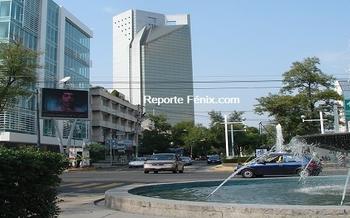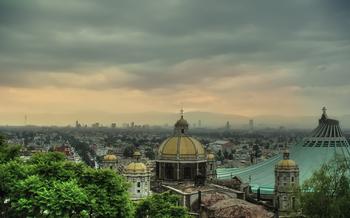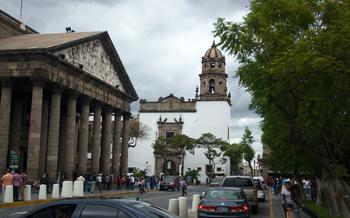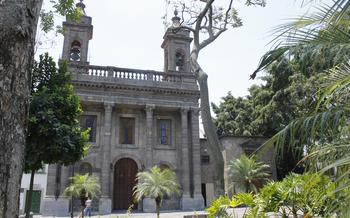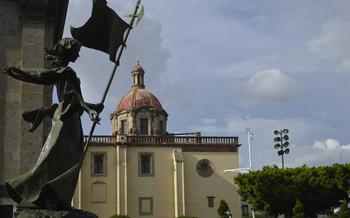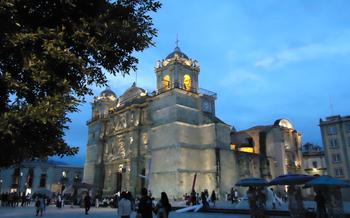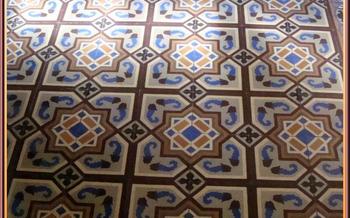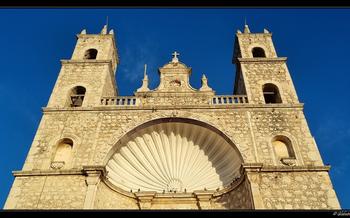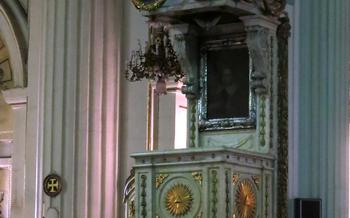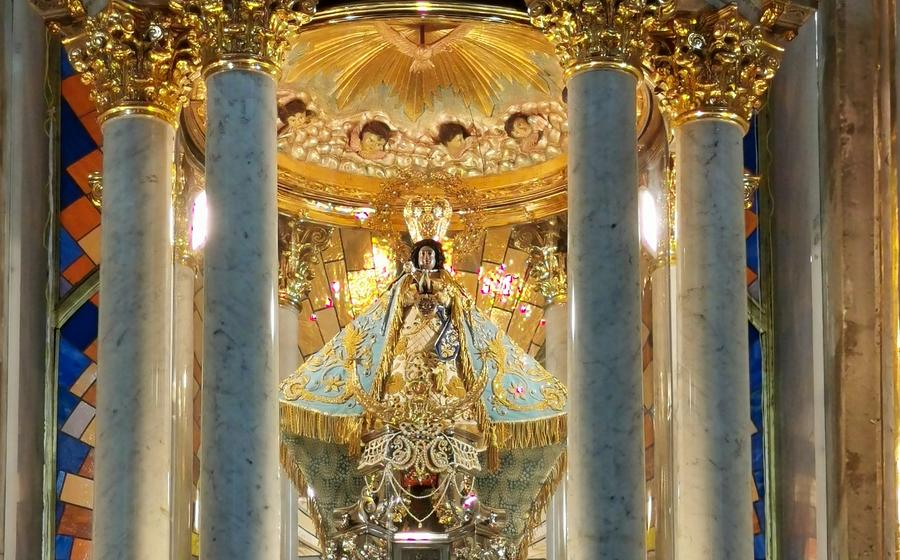
Basilica de Zapopan
- Basilica de Zapopan: A Majestic Symbol of Faith
- Location and Accessibility
- History and Origins
- Architectural Highlights
- Religious Significance
- Must-See Artwork and Relics
- Best Time to Visit
- Tips for a Meaningful Visit
- Explore the Surrounding Area
- Attend a Mass or Special Event
- Capture the Essence of Zapopan
- Local Insights and Anecdotes
- Plan Your Itinerary
- Insider Tip: Hidden Gems
Basilica de Zapopan: A Majestic Symbol of Faith
Nestled in the heart of Zapopan, a vibrant city just northwest of Guadalajara, the Basilica de Zapopan stands as a testament to Mexico's rich history, deep-rooted traditions, and unwavering faith. This iconic landmark, officially known as the Parroquia de Nuestra Señora de la Expectación de Zapopan, is not just an architectural marvel but also a sacred pilgrimage site, attracting millions of devoted Catholics and curious travelers from around the world.
With its origins dating back to the 17th century, the basilica has played a pivotal role in shaping the cultural and religious landscape of the region. Its historical significance is deeply intertwined with the story of the Virgin of Zapopan, a revered wooden statue that is believed to possess miraculous powers and is considered the patron saint of Jalisco state. The basilica serves as the permanent home to this beloved religious icon, drawing countless pilgrims and worshippers seeking blessings, comfort, and spiritual guidance.
Location and Accessibility
The Basilica de Zapopan is situated in the heart of Zapopan, a vibrant city just west of Guadalajara, the capital of Jalisco, Mexico. Its exact address is Plaza de las Americas #1, Zapopan, Jalisco, Mexico. Reaching the basilica is a breeze, thanks to its convenient location and excellent transportation links.
For those relying on public transport, the Zapopan Centro Norte and Periferico Norte stations on the Guadalajara light rail system (Tren Ligero) provide easy access to the basilica. Alternatively, numerous bus routes, including the C110, C116, 619, and 625, stop nearby, ensuring seamless connectivity from various parts of the city.
If driving is your preferred mode of transport, the basilica's strategic location makes it easily accessible by car. Simply follow the signs leading to Zapopan from Guadalajara, and you'll find ample parking spaces available in the vicinity, ensuring a hassle-free visit.
History and Origins
The Basilica de Zapopan's story begins in the early 16th century when Spanish missionaries arrived in the region and established a small chapel dedicated to the Virgin Mary. As the number of faithful grew, the chapel was expanded into a larger church in 1690, which became known as the Parroquia de Zapopan (Zapopan Parish Church).
In 1734, a remarkable event occurred that elevated the church's status and significance: a wooden statue of the Virgin Mary, known as the Virgin of Zapopan, was brought to the church from Guadalajara. This statue, believed to possess miraculous powers, quickly gained a devoted following, and the church became a popular pilgrimage site. In 1941, the church was elevated to the status of a basilica by Pope Pius XII, recognizing its religious and cultural importance.
Architectural Highlights
The Basilica de Zapopan is renowned for its architectural splendor, showcasing a harmonious blend of Neoclassical and Baroque styles. The imposing facade features a triangular pediment supported by elegant Ionic columns, creating a majestic entrance. The highlight of the exterior is the impressive dome, which rises proudly above the skyline, adorned with intricate patterns and crowned by a majestic lantern.
Stepping inside the basilica, visitors are captivated by the ornate interior decorations. The walls are adorned with intricate carvings, frescoes, and paintings depicting religious scenes and stories. The ceiling is a masterpiece of artistry, featuring beautiful frescoes that create an illusion of depth and perspective. The intricate details and vibrant colors of the interior create a sense of awe and reverence.
The basilica boasts an impressive collection of stained glass windows, which flood the interior with a kaleidoscope of colors. Each window tells a unique story from the Bible or the history of the Catholic Church. The play of light through the stained glass creates a magical atmosphere, transforming the basilica into a sacred space that invites contemplation and reflection.
Religious Significance
The Basilica de Zapopan holds immense religious significance for the people of Mexico, particularly those in the state of Jalisco. It is dedicated to the Virgin of Zapopan, who is revered as the patron saint of the state. The basilica serves as a pilgrimage site for thousands of devotees who come to pay homage to the Virgin and seek her blessings. Throughout the year, the basilica hosts various religious celebrations and festivals, including the annual pilgrimage in October, which attracts millions of pilgrims from across the country. The basilica is also associated with numerous miracles and devotions, further solidifying its reputation as a sacred and spiritual place. Whether you are a devout Catholic or simply someone interested in religious history and traditions, a visit to the Basilica de Zapopan is a truly enriching experience.
Must-See Artwork and Relics
Step inside the Basilica de Zapopan and prepare to be captivated by the stunning artwork and relics that adorn its sacred spaces. The centerpiece of the basilica is undoubtedly the revered statue of the Virgin of Zapopan, a masterpiece of religious artistry. This wooden sculpture, crafted with intricate detail and adorned with precious jewels, draws pilgrims and devotees from far and wide.
Throughout the basilica, you'll find a collection of ornate altars, each dedicated to a different saint or religious figure. These altars are adorned with intricate carvings, opulent gold leaf, and colorful paintings that depict biblical scenes and stories. The basilica's stained-glass windows are also a sight to behold, casting a kaleidoscope of colors onto the marble floors below.
In addition to the Virgin of Zapopan statue, the basilica houses a number of other sacred relics and artifacts. Among these are the remains of Saint Toribio Romo, a Mexican priest who was martyred in 1928 and is now considered a patron saint of the city. Visitors can also view the original baptismal font where the city's founder, Miguel Hidalgo, was baptized in 175
Best Time to Visit
The best time to visit the Basilica de Zapopan depends on your preferences and interests. During the peak season (December to April), the weather is pleasant and there are many cultural events and festivals. However, this is also the busiest time, with large crowds and higher prices.
If you prefer a more peaceful and intimate experience, consider visiting during the off-season (May to November). The weather is still warm, but there are fewer tourists and prices are lower.
Special events and festivals are held throughout the year, offering unique opportunities to witness the basilica's vibrant religious traditions. Check the basilica's website or local tourism offices for a calendar of events.
No matter when you choose to visit, make sure to dress appropriately and behave respectfully, as the basilica is an active place of worship.
Tips for a Meaningful Visit
When visiting the Basilica de Zapopan, it's important to be mindful of the religious significance and cultural sensitivity of the site. Here are some tips to ensure a respectful and meaningful experience:
-
Dress Code and Etiquette: Dress modestly and avoid wearing shorts, tank tops, or revealing clothing. Be respectful of the sacred space and maintain a quiet and solemn demeanor.
-
Respectful Behavior: Refrain from talking loudly, laughing, or engaging in disruptive behavior. Be mindful of others who are praying or seeking a moment of contemplation.
-
Photography Guidelines: Photography is generally allowed inside the basilica, but be respectful and avoid using flash or taking photos during mass or religious ceremonies. Ask permission before photographing individuals or groups.
-
Guided Tours and Audio Guides: Take advantage of guided tours or audio guides to learn more about the history, architecture, and religious significance of the basilica. These tours provide valuable insights and enhance your understanding of the site.
Explore the Surrounding Area
After immersing yourself in the spiritual and architectural wonders of the Basilica de Zapopan, take some time to explore the vibrant surroundings. Just a short stroll away, you'll find the bustling Zapopan Market, a feast for the senses where you can browse traditional Mexican handicrafts, savor local delicacies, and haggle for souvenirs. For a taste of contemporary culture, head to the nearby Zapopan Art Center, which hosts exhibitions by local and international artists, as well as workshops and performances.
For a glimpse into Zapopan's rich history, visit the Museo de las Artes Populares de Jalisco (Museum of Popular Arts of Jalisco), which showcases traditional Mexican crafts from pottery and textiles to wood carvings and jewelry. If you're in the mood for some outdoor recreation, the Parque Metropolitano de Zapopan is a sprawling urban park with jogging trails, playgrounds, and picnic areas, offering a tranquil escape from the city's hustle and bustle.
Attend a Mass or Special Event
Embrace the Spiritual Atmosphere
At the heart of the Basilica de Zapopan, the religious ceremonies and special events bring the sacred space to life. Immerse yourself in the spiritual atmosphere by attending a mass, where you can witness the devotion of the faithful and become a part of the local religious traditions.
Masses are held daily at the basilica, allowing you to align your visit with your spiritual needs. Major religious celebrations, such as the Feast of Our Lady of Zapopan, attract thousands of pilgrims and offer a vibrant spectacle of colors, music, and cultural expressions.
If you're fortunate to be in Zapopan during one of these special events, prepare to be captivated by the vibrant processions, musical performances, and festive atmosphere that fill the streets and the basilica. These celebrations are a testament to the deep-rooted faith and cultural heritage of the region.
Music concerts and exhibitions are also held throughout the year, transforming the basilica into a venue for artistic expression and spiritual reflection. Keep an eye out for these events and seize the opportunity to experience the basilica's grandeur in a unique and unforgettable way.
Capture the Essence of Zapopan
Embrace the beauty of the Basilica de Zapopan through photography and share your experience with the world. Capture stunning views of the neoclassical facade, the majestic dome, and the intricate details of the interior. Don't miss the opportunity to photograph the revered Virgin of Zapopan statue, a symbol of faith and devotion for the local community.
Share your Instagrammable moments with friends and followers, using hashtags like #BasilicaDeZapopan, #Guadalajara, and #Mexico. Share your thoughts and feelings about the basilica, the surrounding area, and the vibrant culture of Zapopan. Your experiences can inspire others to embark on their pilgrimage to this sacred site.
Support local artisans by purchasing souvenirs and traditional crafts from the surrounding shops. Find unique pieces that reflect the rich cultural heritage of Zapopan, such as handcrafted pottery, colorful textiles, and intricate silver jewelry. These souvenirs will serve as lasting mementos of your visit and contribute to the local economy.
Local Insights and Anecdotes
Zapopan is a city brimming with stories, legends, and local traditions that add to the charm of the Basilica.
-
One of the most intriguing tales is the legend of the Virgin of Zapopan's miraculous appearance. According to local lore, the Virgin Mary appeared to a humble indigenous man named Juan Diego in the 16th century, instructing him to build a chapel in her honor.
-
Another cherished tradition is the annual pilgrimage to the Basilica. Each October, thousands of devoted pilgrims from all over Mexico and beyond make the journey to Zapopan on foot, seeking blessings and paying homage to the Virgin.
-
Zapopan's rich history is also intertwined with fascinating local characters. One such figure is Fray Antonio Alcalde, the 18th-century bishop who played a pivotal role in the Basilica's construction and expansion.
-
In recent years, Zapopan has emerged as a vibrant cultural hub, attracting artists, musicians, and creatives from across the region. The city's thriving art scene is evident in its many galleries, studios, and public art installations, providing visitors with a glimpse into the city's contemporary identity.
-
Whether you're a history buff, a spiritual seeker, or simply curious about local culture, Zapopan offers a wealth of stories and experiences that will enrich your visit to the Basilica.
Plan Your Itinerary
To make the most of your visit to the Basilica de Zapopan, planning a well-structured itinerary is crucial. Here's a suggested walking route for a comprehensive and enjoyable experience:
Main Entrance: Begin your journey at the main entrance of the basilica, which showcases its impressive Neoclassical facade.
Interior Exploration: Step inside to marvel at the ornate decorations, intricate stained glass windows, and the awe-inspiring dome.
Virgin of Zapopan: Pay homage to the Virgin of Zapopan, the patron saint of Jalisco, whose statue is the focal point of the basilica.
Side Altars: Explore the side altars, each dedicated to a different saint or devotion, offering a glimpse into the basilica's rich religious history.
Sacristy: If accessible, visit the sacristy to admire the collection of sacred objects, historical artifacts, and vestments used in religious ceremonies.
Courtyard and Gardens: Take a moment to relax in the peaceful courtyard or stroll through the well-manicured gardens surrounding the basilica.
Mirador: Climb to the mirador (viewpoint) for breathtaking panoramic city views and a unique perspective of the basilica's grandeur.
Zapopan Museum: Enhance your understanding of the basilica's significance by visiting the Zapopan Museum, located nearby, which houses exhibits on its history and cultural importance.
Plaza de las Américas: Conclude your visit at the adjacent Plaza de las Américas, a vibrant public square with fountains, sculptures, and local vendors.
Depending on your interests and time constraints, you can allocate 1-2 hours for a comprehensive visit to the basilica and its surroundings. Consider combining your basilica visit with other nearby attractions, such as the Museo de Arte de Zapopan (Zapopan Art Museum) or the Centro Cultural de Zapopan (Zapopan Cultural Center), to create a fulfilling and memorable cultural experience.
Insider Tip: Hidden Gems
Beyond the main attractions, there are hidden gems waiting to be discovered at the Basilica de Zapopan. Explore the side chapels to uncover intricate artworks and stories of local saints. Take a moment to admire the choir loft, with its finely carved wooden panels and ornate detailing. If you visit during the annual Zapopan Fair, don't miss the traditional dances and performances held in the basilica's courtyard. For a unique perspective, climb to the basilica's rooftop terrace for panoramic city views. Ask a local guide about the legends surrounding the basilica's bells, which are said to possess miraculous powers.
